- Home
- Barbara Kingsolver
Animal, Vegetable, Miracle Page 2
Animal, Vegetable, Miracle Read online
Page 2
We’d surely do better, if only we knew any better. In two generations we’ve transformed ourselves from a rural to an urban nation. North American children begin their school year around Labor Day and finish at the beginning of June with no idea that this arrangement was devised to free up children’s labor when it was needed on the farm. Most people of my grandparents’ generation had an intuitive sense of agricultural basics: when various fruits and vegetables come into season, which ones keep through the winter, how to preserve the others. On what day autumn’s first frost will likely fall on their county, and when to expect the last one in spring. Which crops can be planted before the last frost, and which must wait. Which grains are autumn-planted. What an asparagus patch looks like in August. Most importantly: what animals and vegetables thrive in one’s immediate region and how to live well on those, with little else thrown into the mix beyond a bag of flour, a pinch of salt, and a handful of coffee. Few people of my generation, and approximately none of our children, could answer any of those questions, let alone all. This knowledge has vanished from our culture.
We also have largely convinced ourselves it wasn’t too important. Consider how Americans might respond to a proposal that agriculture was to become a mandatory subject in all schools, alongside reading and mathematics. A fair number of parents would get hot under the collar to see their kids’ attention being pulled away from the essentials of grammar, the all-important trigonometry, to make room for down-on-the-farm stuff. The baby boom psyche embraces a powerful presumption that education is a key to moving away from manual labor, and dirt—two undeniable ingredients of farming. It’s good enough for us that somebody, somewhere, knows food production well enough to serve the rest of us with all we need to eat, each day of our lives.
If that is true, why isn’t it good enough for someone else to know multiplication and the contents of the Bill of Rights? Is the story of bread, from tilled ground to our table, less relevant to our lives than the history of the thirteen colonies? Couldn’t one make a case for the relevance of a subject that informs choices we make daily—as in, What’s for dinner? Isn’t ignorance of our food sources causing problems as diverse as overdependence on petroleum, and an epidemic of diet-related diseases?
If this book is not exactly an argument for reinstating food-production classes in schools (and it might be), it does contain a lot of what you might learn there. From our family’s gas-station beginnings we have traveled far enough to discover ways of taking charge of one’s food, and even knowing where it has been. This is the story of a year in which we made every attempt to feed ourselves animals and vegetables whose provenance we really knew. We tried to wring most of the petroleum out of our food chain, even if that meant giving up some things. Our highest shopping goal was to get our food from so close to home, we’d know the person who grew it. Often that turned out to be us, as we learned to produce more of what we needed, starting with dirt, seeds, and enough knowledge to muddle through. Or starting with baby animals and enough sense to refrain from naming them.
This is not a how-to book aimed at getting you cranking out your own food. We ourselves live in a region where every other house has a garden out back, but to many urban people the idea of growing your food must seem as plausible as writing and conducting your own symphonies for your personal listening pleasure. If that is your case, think of the agricultural parts of the story as a music appreciation course for food—acquainting yourself with the composers and conductors can improve the quality of your experience. Knowing the secret natural history of potatoes, melons, or asparagus gives you a leg up on detecting whether those in your market are wholesome kids from a nearby farm, or vagrants who idled away their precious youth in a boxcar. Knowing how foods grow is to know how and when to look for them; such expertise is useful for certain kinds of people, namely, the ones who eat, no matter where they live or grocery shop.
Absence of that knowledge has rendered us a nation of wary label-readers, oddly uneasy in our obligate relationship with the things we eat. We call our food animals by different names after they’re dead, presumably sparing ourselves any vision of the beefs and the porks running around on actual hooves. Our words for unhealthy contamination—“soiled” or “dirty”—suggest that if we really knew the number-one ingredient of a garden, we’d all head straight into therapy. I used to take my children’s friends out to the garden to warm them up to the idea of eating vegetables, but this strategy sometimes backfired: they’d back away slowly saying, “Oh man, those things touched dirt!” Adults do the same by pretending it all comes from the clean, well-lighted grocery store. We’re like petulant teenagers rejecting our mother. We know we came out of her, but ee-ew.
We don’t know beans about beans. Asparagus, potatoes, turkey drum-sticks—you name it, we don’t have a clue how the world makes it. I usually think I’m exaggerating the scope of the problem, and then I’ll encounter an editor (at a well-known nature magazine) who’s nixing the part of my story that refers to pineapples growing from the ground. She insisted they grew on trees. Or, I’ll have a conversation like this one:
“What’s new on the farm?” asks my friend, a lifelong city dweller who likes for me to keep her posted by phone. She’s a gourmet cook, she cares about the world, and has been around a lot longer than I have. This particular conversation was in early spring, so I told her what was up in the garden: peas, potatoes, spinach.
“Wait a minute,” she said. “When you say, ‘The potatoes are up,’ what do you mean?” She paused, formulating her question: “What part of a potato comes up?”
“Um, the plant part,” I said. “The stems and leaves.”
“Wow,” she said. “I never knew a potato had a plant part.”
Many bright people are really in the dark about vegetable life. Biology teachers face kids in classrooms who may not even believe in the metamorphosis of bud to flower to fruit and seed, but rather, some continuum of pansies becoming petunias becoming chrysanthemums; that’s the only reality they witness as landscapers come to campuses and city parks and surreptitiously yank out one flower before it fades from its prime, replacing it with another. (My biology-professor brother pointed this out to me.) The same disconnection from natural processes may be at the heart of our country’s shift away from believing in evolution. In the past, principles of natural selection and change over time made sense to kids who’d watched it all unfold. Whether or not they knew the terms, farm families understood the processes well enough to imitate them: culling, selecting, and improving their herds and crops. For modern kids who intuitively believe in the spontaneous generation of fruits and vegetables in the produce section, trying to get their minds around the slow speciation of the plant kingdom may be a stretch.
Steven, also a biology professor, grew up in the corn belt of Iowa but has encountered his share of agricultural agnostics in the world. As a graduate student he lived in an urban neighborhood where his little backyard vegetable garden was a howling curiosity for the boys who ran wild in the alley. He befriended these kids, especially Malcolm, known throughout the neighborhood as “Malcolm-get-your-backside-in-here-now-or-you-won’t-be-having-no-dinner!” Malcolm liked hanging around when Steven was working in the garden, but predictably enough, had a love-hate thing with the idea of the vegetables touching the dirt. The first time he watched Steven pull long, orange carrots out of the ground, he demanded: “How’d you get them in there?”
Steven held forth with condensed Intro Botany. Starts with a seed, grows into a plant. Water, sunlight, leaves, roots. “A carrot,” Steven concluded, “is actually a root.”
“Uh-huh…,” said Malcolm doubtfully.
A crowd had gathered now. Steven engaged his audience by asking, “Can you guys think of other foods that might be root vegetables?”
Malcolm checked with his pals, using a lifeline before confidently submitting his final answer: “Spaghetti?”
We can’t know what we haven’t been taught. Steven couldn’t re
cognize tobacco in vivo before moving in his twenties to southwestern Virginia, where the tobacco leaf might as well be the state flag. One Saturday morning soon after he’d moved, he was standing on a farmer’s porch at a country yard sale when a field of giant, pale leaves and tall pink flower spikes caught his eye. He asked the farmer the name of this gorgeous plant. The man grinned hugely and asked, “You’re not from here, are you, son?”
That farmer is probably still telling this story; Steven is his Malcolm. Every one of us is somebody’s Malcolm. Country folks can be as food-chain-challenged as the city mice, in our own ways. Rural southern cooking is famous for processed-ingredient recipes like Coca-Cola cake, and plenty of rural kids harbor a potent dread of compost and earthworms. What we all don’t know about farming could keep the farmers laughing until the cows come home. Except that they are barely making a living, while the rest of us play make-believe about the important part being the grocery store.
When we walked as a nation away from the land, our knowledge of food production fell away from us like dirt in a laundry-soap commercial.
Now, it’s fair to say, the majority of us don’t want to be farmers, see farmers, pay farmers, or hear their complaints. Except as straw-chewing figures in children’s books, we don’t quite believe in them anymore. When we give it a thought, we mostly consider the food industry to be a thing rather than a person. We obligingly give 85 cents of our every food dollar to that thing, too—the processors, marketers, and transporters. And we complain about the high price of organic meats and vegetables that might send back more than three nickels per buck to the farmers: those actual humans putting seeds in the ground, harvesting, attending livestock births, standing in the fields at dawn casting their shadows upon our sustenance. There seems to be some reason we don’t want to compensate or think about these hardworking people. In the grocery store checkout corral, we’re more likely to learn which TV stars are secretly fornicating than to inquire as to the whereabouts of the people who grew the cucumbers and melons in our carts.
This drift away from our agricultural roots is a natural consequence of migration from the land to the factory, which is as old as the Industrial Revolution. But we got ourselves uprooted entirely by a drastic reconfiguration of U.S. farming, beginning just after World War II. Our munitions plants, challenged to beat their swords into plowshares, retooled to make ammonium nitrate surpluses into chemical fertilizers instead of explosives. The next explosions were yields on midwestern corn and soybean fields. It seemed like a good thing, but some officials saw these new surpluses as reason to dismantle New Deal policies that had helped farmers weather the economic uncertainties notorious to their vocation. Over the next decades, nudged by industry, the government rewrote the rules on commodity subsidies so these funds did not safeguard farmers, but instead guaranteed a supply of cheap corn and soybeans.
These two crops, formerly food for people and animals, became something entirely new: a standardized raw material for a new extractive industry, not so different from logging or mining. Mills and factories were designed for a multibranched production line as complex as the one that turns iron and aluminum ores into the likes of automobiles, paper clips, and antiperspirants. But instead, this new industry made piles of corn and soybeans into high-fructose corn syrup, hydrogenated oils, and thousands of other starch-or oil-based chemicals. Cattle and chickens were brought in off the pasture into intensely crowded and mechanized CAFOs (concentrated animal feeding operations) where corn—which is no part of a cow’s natural diet, by the way—could be turned cheaply and quickly into animal flesh. All these different products, in turn, rolled on down the new industrial food pipeline to be processed into the soft drinks, burgers, and other cheap foods on which our nation now largely runs—or sits on its bottom, as the case may be.
This is how 70 percent of all our midwestern agricultural land shifted gradually into single-crop corn or soybean farms, each one of them now, on average, the size of Manhattan. Owing to synthetic fertilizers and pesticides, genetic modification, and a conversion of farming from a naturally based to a highly mechanized production system, U.S. farmers now produce 3,900 calories per U.S. citizen, per day. That is twice what we need, and 700 calories a day more than they grew in 1980. Commodity farmers can only survive by producing their maximum yields, so they do. And here is the shocking plot twist: as the farmers produced those extra calories, the food industry figured out how to get them into the bodies of people who didn’t really want to eat 700 more calories a day. That is the well-oiled machine we call Late Capitalism.
Most of those calories enter our mouths in forms hardly recognizable as corn and soybeans, or even vegetable in origin: high-fructose corn syrup (HFCS) owns up to its parentage, but lecithin, citric acid, maltodextrin, sorbitol, and xanthan gum, for example, are also manufactured from corn. So are beef, eggs, and poultry, in a different but no less artificial process. Soybeans also become animal flesh, or else a category of ingredient known as “added fats.” If every product containing corn or soybeans were removed from your grocery store, it would look more like a hardware store. Alarmingly, the lightbulbs might be naked, since many packaging materials also now contain cornstarch.
With so many extra calories to deliver, the packages have gotten bigger. The shapely eight-ounce Coke bottle of yesteryear became twenty ounces of carbonated high-fructose corn syrup and water; the accompanying meal morphed similarly. So did the American waistline. U.S. consumption of “added fats” has increased by one-third since 1975, and our HFCS is up by 1000 percent. About a third of all our calories now come from what is known, by community consent, as junk food.
No cashier held a gun to our heads and made us supersize it, true enough. But humans have a built-in weakness for fats and sugar. We evolved in lean environments where it was a big plus for survival to gorge on calorie-dense foods whenever we found them. Whether or not they understand the biology, food marketers know the weakness and have exploited it without mercy. Obesity is generally viewed as a failure of personal resolve, with no acknowledgment of the genuine conspiracy in this historical scheme. People actually did sit in strategy meetings discussing ways to get all those surplus calories into people who neither needed nor wished to consume them. Children have been targeted especially; food companies spend over $10 billion a year selling food brands to kids, and it isn’t broccoli they’re pushing. Overweight children are a demographic in many ways similar to minors addicted to cigarettes, with one notable exception: their parents are usually their suppliers. We all subsidize the cheap calories with our tax dollars, the strategists make fortunes, and the overweight consumers get blamed for the violation. The perfect crime.
All industrialized countries have experienced some commodification of agriculture and increased consumption of processed foods. But nowhere else on earth has it become normal to layer on the love handles as we do. (Nude beaches are still popular in Europe.) Other well-fed populations have had better luck controlling caloric excess through culture and custom: Italians eat Italian food, the Japanese eat Japanese, and so on, honoring ancient synergies between what their land can give and what their bodies need. Strong food cultures are both aesthetic and functional, keeping the quality and quantity of foods consumed relatively consistent from one generation to the next. And so, while the economies of many Western countries expanded massively in the late twentieth century, their citizens did not.
Here in the U.S. we seem puzzled by these people who refrain from gluttony in the presence of a glut. We’ve even named a thing we call the French Paradox: How can people have such a grand time eating cheese and fattened goose livers and still stay slim? Having logged some years in France, I have some hunches: they don’t suck down giant sodas; they consume many courses in a meal but the portions of the fatty ones tend to be tiny; they smoke like chimneys (though that’s changing); and they draw out meals sociably, so it’s not just about shoveling it in. The all-you-can-eat buffet is an alien concern to the French, to put it mildl
y. Owing to certain rules about taste and civility in their heads, their bodies seem to know when enough is enough. When asked, my French friends have confided with varying degrees of tact that the real paradox is how people manage to consume, so very much, the scary food of America.
Why do we? Where are our ingrained rules of taste and civility, our ancient treaties between our human cravings and the particular fat of our land? Did they perhaps fly out the window while we were eating in a speeding car?
Food culture in the United States has long been cast as the property of a privileged class. It is nothing of the kind. Culture is the property of a species. Humans don’t do everything we crave to do—that is arguably what makes us human. We’re genetically predisposed toward certain behaviors that we’ve collectively decided are unhelpful; adultery and racism are possible examples. With reasonable success, we mitigate those impulses through civil codes, religious rituals, maternal warnings—the whole bag of tricks we call culture. Food cultures concentrate a population’s collective wisdom about the plants and animals that grow in a place, and the complex ways of rendering them tasty. These are mores of survival, good health, and control of excess. Living without such a culture would seem dangerous.

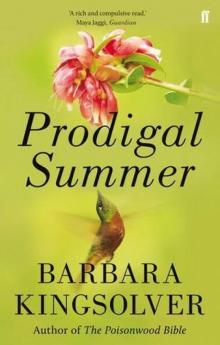 Prodigal Summer: A Novel
Prodigal Summer: A Novel Animal Dreams: A Novel
Animal Dreams: A Novel The Poisonwood Bible
The Poisonwood Bible High Tide in Tucson
High Tide in Tucson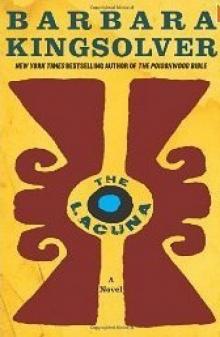 The Lacuna
The Lacuna The Bean Trees
The Bean Trees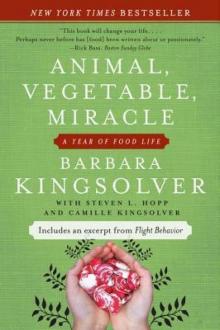 Animal, Vegetable, Miracle: A Year of Food Life
Animal, Vegetable, Miracle: A Year of Food Life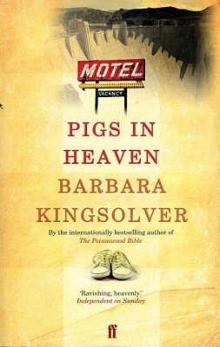 Pigs in Heaven
Pigs in Heaven Small Wonder
Small Wonder Flight Behavior
Flight Behavior Homeland and Other Stories
Homeland and Other Stories How to Fly (In Ten Thousand Easy Lessons)
How to Fly (In Ten Thousand Easy Lessons) Unsheltered
Unsheltered Animal Dreams
Animal Dreams Prodigal Summer
Prodigal Summer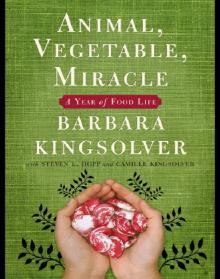 Animal, Vegetable, Miracle
Animal, Vegetable, Miracle